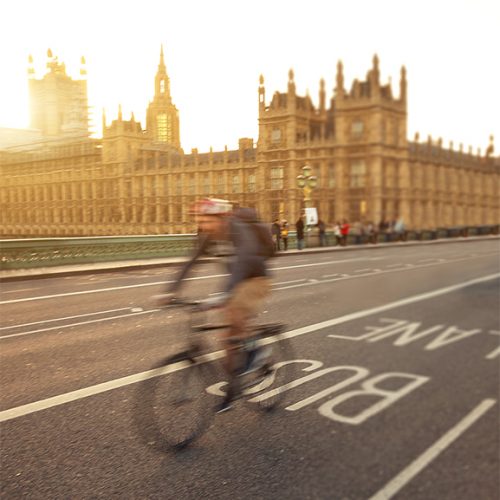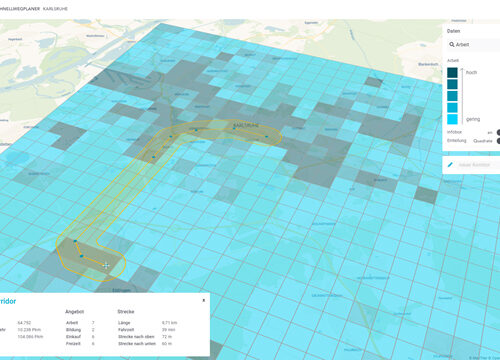While politicians and the public are discussing climate protection, mobility transformation is already rolling on two-wheels: In 2020, sales of bicycles in Europe rose by 47% compared to the previous year. However, while many people want to cycle more, they are being held back because of a lack of suitable transport infrastructure in many places. To enable cyclists not only to cycle more, but to do so in new areas, experts are calling for high-speed cycleways. Those “bicycle highways” extend the radius of movement, increase safety, and thus pave the way for an increasing number of cyclists.
“More space, more money, more rights are needed,” demand climate and bicycle activists who support mobility transformation. The safety of cyclists plays a crucial role, so it is not enough to simply paint streets and declare them as bicycle lanes. Calls for bike lanes on which children can ride safely and which are not blocked by parking violations are becoming louder and louder. Cities and municipalities are called upon to create suitable infrastructure.
Bicycle to protect the climate
Metropolitan regions around the world all battle the same problem: More people mean more traffic. This leads to more traffic jams, more accidents, poorer air quality and a decline in the quality of life. The search for better solutions is driving experts around the world. More bicycle use can contribute to solving those traffic problems:
- It is the most efficient of all modes of transport, taking only one-tenth the space of a car for parking and only one-fifth for getting around.
- It costs much less than public transit and is affordable for all.
- It makes no noise, conserves resources and the climate.
- It promotes quality of life, social interaction among people – and health

Politicians can help make bicycle the favorite mean of transport. They can do so by simplifying laws and regulations, enabling municipalities to easily build suitable infrastructure. Bicycle-friendly communities will be created through determined policies and the redistribution of road space.
In Germany, for example, an important building block is the National Cycling Plan 3.0 (NRVP). This plan by the Federal Ministry of Transport and Digital Infrastructure received expert support from PTV Group and Fraunhofer ISI and was coordinated by ifok GmbH. Both experts and citizens were involved in the development of the plan and suggested new approaches for promotion of cycling in Germany. The ideas were incorporated into the plan, which aims to make Germany a “cycling nation” by 2030 the latest.
In Germany, the federal states are tasked with building inter-regional cycleway networks and help municipalities get federal funds to promote cycling. At the core, mobility transformation is happening in the Municipalities though: It is them, who work and realize concepts for reduced use of cars, build cycle lanes and cycleways, create millions of bike parking spaces, identify, and defuse dangerous intersections. This, of course, while strengthening public transportation and pedestrian traffic, as pushing all three is the key to success.
Cycleways
Cycleways are undoubtedly great for increasing the cyclists’ radius. They also make longer routes more attractive for cyclists and empower E-bikes to max out their speed level.
Building of cycleways requires holistic planning and construction. All aspects of cycling infrastructure should be taken into account, such as good lighting and clear pavement markings and signage.
The Bicycle Planner
Where do people start their journey by bike? Where are they heading to? The Bicycle Planner is a very simple way for cities and municipalities to know where to locate the main corridors for potential cycling infrastructure. It is data-based, methodologically sound, and comprehensible for a wide audience.
To this end, the online tool provides information on residential population, jobs, student and pupil numbers, and commuter volumes. This information base can be further enriched with the user’s own data. For example, cities and municipalities can add figures on environmental zones, new development areas or population growth.

From potential analysis to demand-based modeling
For an initial potential analysis of cycling infrastructure, the following aspects are important: Where do people live? Where are jobs located, where are schools and shopping facilities?
Tools for visualizing and analyzing data, such as the Bicycle Planner, provide information about the potential of corridors with just a few clicks and show how many routes can be shifted to bicycles, if the infrastructure is expanded.
In this way, cities and municipalities can get an overview of their planned infrastructure, and whether it will increase bicycle use. Subsequently, they can analyze where a new cycleway should be located.
The same applies to environmental aspects of bicycle infrastructure planning. Ideally, no new areas should be paved. Disused railroad tracks, for example, can be transformed into new cycleways.
Once the rough planning is done, it is time to get down to the details. Not only is the main route considered, but also the potential along this corridor. Here, a transport model that you feed with relevant structural data and that can be used to model exact demand is worth its weight in gold. This allows cities and municipalities to see, for example, what effects a high-speed bike path between two centers will also have on suburbs or destinations along the route.
For decades, we have focused our attention on the car. Now it is important that other modes become more present and cycling is taken seriously.
